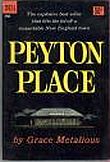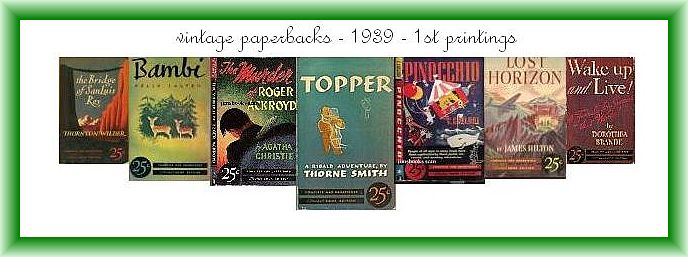The full-page ad in the June 19, 1939 edition of the New York Times titled “The New Pocket Books that may revolutionize New York’s reading habit,” read: Today is the most important literary coming-out party in the memory of New York’s oldest book lover. Today your 25 cent piece leaps to a par with dollar bills….These new Pocket Books are designed to fit both the tempo of our times and the needs of New Yorkers….Never again need you say “I wish I had time to read” because Pocket Books gives you the time….The books you have always meant to read “when you had time” will fill the waits with enjoyment.
The new inexpensive book was the design of book entrepreneur, Robert de Graff who had done his market research in 1938 by sending out 1000 copies of a trial edition of Pearl Buck’s The Good Earth and requesting the recipients’ opinion on whether they were willing to spend a quarter for such a book. Inexpensive paperback reprints such as the British Penguins were already available, but De Graff was targeting a whole new reading public that had never ventured into bookstores, and had never considered paying $2 for a book. Needless to say, the test was a success and the American mass-market paperback was born.
During 1939, De Graff shipped not only to bookstores and department stores, but also to newsstands, drugstores and tobacco stores more than 1,500,000 Pocket Books. Titles included a range of works such as James Hilton’s Lost Horizon, The Bridge of San Luis Rey by Thornton Wilder, Topper by Thorne Smith, The Murder of Roger Ackroyd by Agatha Christie, Bambi by Felix Salten, and so forth.
Collectors of these and other paperbacks are attracted to these books because of their historic importance. Considered to be cheap format reprints with cover illustrations, they have nothing much to be excited about. With the exception of some of the science fiction releases that had their true first edition in paperback format, almost all of the paperbacks are reprints. Given their historic importance however, collectors have been able to detect value in any of the 1939 Pocket Books. They did revolutionize the book publishing industry, after all.
The first printings of these early titles are very scarce, and copies that are in good condition demand premium pricing. Besides the effects of old age, the books were bound with a perm-gloss acetate covering that has a tendency to peel off as time progresses. High-speed production techniques utilized during the 1930s were quite primitive, limiting the mass production of first printings to a few thousand copies. Moreover, with the less caring reading habits of the busy people who handled the inexpensive, portable paperbacks, a shortage in the first printings of these early titles was inevitable.
Once the modern paperback revolution was underway, the American publishing industry underwent a period of re-adjustment through mergers and acquisitions. This transformation elevated some of the later editions, such as the 1957 Dell reprint of the Grace Metalious novel Payton Place, to historic importance. The hardback sold 60,000 copies within the first ten days of its release, and it remained on the New York Times best seller list for 59 weeks. Additionally, it was adapted as both a 1957 film, and a 1964–69 television series. The success of Peyton Place in paperback format propelled Dell to new heights that allowed the major paperback publisher to launch its own hardback imprints, Dial and Delacorte in the 1960s. Dell was acquired by Doubleday in 1976. Copies of the Payton Place first printing can still be picked up at reasonable prices.
Collectors looking for the 1938 edition of The Good Earth used in De Graff’s marketing survey are likely to be disappointed, as it is very scarce. In fact, any of the first printings of the first Pocket Book publications from 1939 are quite difficult to find in very good condition. Some of these such as the #1 release of Lost Horizon are selling for more than a few hundred dollars, even when the condition has much to be desired. Seven decades later, as the paperback book is being challenged by the electronic book, one thing remains for sure: the demand for vintage paperbacks will keep on growing, while the supply is shrinking.



{ 3 comments… read them below or add one }
I have a Pocket Book without a publication date. It’s title is ” Chesapeake Cavalier” & it’s in fairly good condition. What does it mean if it doesn’t have a publishing date?
I have a collection of collector’s edition pocket books dated 1951. Beautifully hardbound. Edgar Allan Poe is #32 and I have 15 more.
I also have volumes 1-6 of hardbound books of Abraham Lincoln’s Story of a great life putvout by C.S. Hammond &Co. Copyrighted 1908 and a hardbound copy of Uncle Tom’s Cabin published by J. H. Sears and Co. New York.
Are any of these of value?
My book
Pocket Books Collector’s Edition
Four Great Tragedies by William Shakespeare
Pocket Books , Inc., New York
{ 1 trackback }